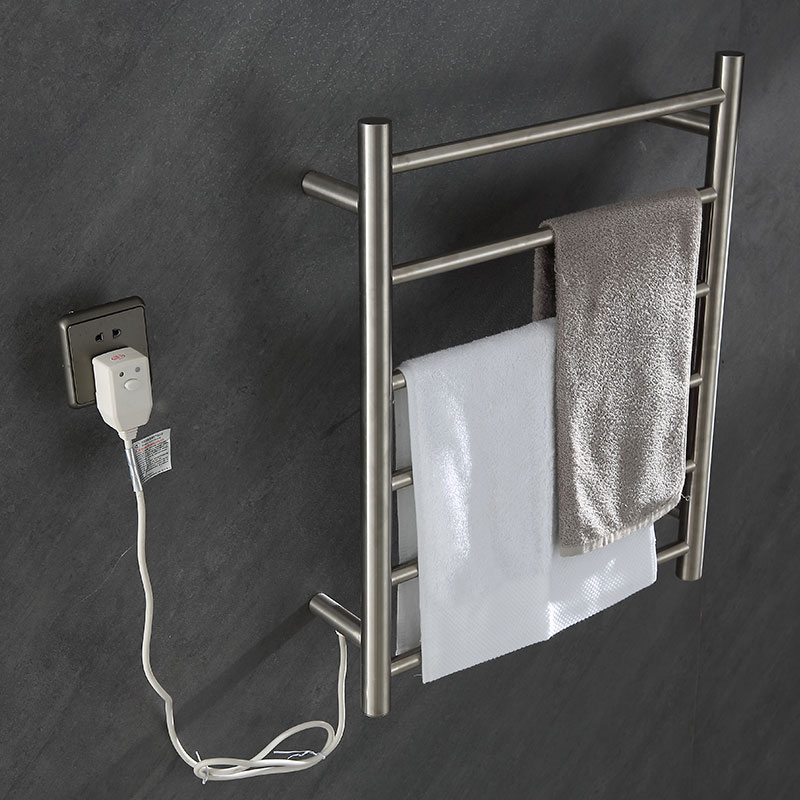How To Install An Electric Heated Towel Rail
Installing an electric heated towel rail is a high-impact upgrade that delivers warm, dry towels and a fresher bathroom with surprisingly modest energy use. This guide explains how to install an electric heated towel rail from planning to commissioning, showing professional techniques that reduce rework and keep your project compliant. It applies to both dry-element and oil-filled models and covers hardwired and plug-in variants. Our Electric Towel Rack range is designed for straightforward mounting, accurate temperature control, and safe bathroom operation.
1) Plan Before You Drill: Codes, Positioning, and Power
Confirm compliance and protection
Bathrooms are wet zones, so electrical protection is non-negotiable. Your rail’s rating plate must match the bathroom IP (Ingress Protection) zone where it will be installed. As a rule of thumb: the closer to water sources, the higher the IP rating required. Ensure the circuit is protected by a residual current device (RCD/GFCI) and that the breaker and cable gauge suit the rail’s wattage. If local regulations require a licensed electrician for final connections, schedule one now to avoid delays at the end.
Choose hardwired or plug-in
Hardwired rails hide the cable in the wall and connect through a fused spur or junction box—this is the cleanest look for permanent installs. Plug-in rails route the cord to a bathroom-rated outlet placed outside splash zones. If you’re planning a remodel or new build, hardwiring is ideal; if you’re retrofitting without opening walls, plug-in can be the faster option.
Pick the optimal height and spacing
For everyday comfort and efficient drying, set the top bar roughly at chest height for the primary user. Leave at least 150–200 mm (6–8 in) of clearance above the floor to prevent splashes and to ease cleaning. The rack should be reachable from the shower exit without dripping across the room. Mark stud locations to anchor the heavier side of the rail; if the wall is tiled drywall, plan blocking or hollow-wall anchors rated for the rack’s mass.
Map cable routing and isolation point
For hardwired models, the supply cable typically exits behind a lower bar. Confirm whether the cable exit is left or right, and ensure your isolation point (switched fused spur or junction box) is on the same side to avoid long diagonal runs. Keep the cable inside a vertical chase where possible; avoid sharp bends that can pinch the sheath.
Align with towels and room airflow
Rails heat by radiation and convection. Avoid recessing them behind doors or heavy curtains. Leave at least 50 mm (2 in) between rail and wall to allow airflow up the back. Plan bar spacing for your usual towel sizes; wide bars plus a mid-gap of 90–120 mm help moisture escape, speeding drying and reducing runtime.
2) Tools, Fixings, and Mounting: From Layout to Level
Gather the right kit
You’ll need: stud finder, non-contact voltage tester, tape measure, level, masking tape, mounting template (or the rail itself), masonry/ceramic tile bits, multi-material anchors, screwdriver, driver bits, silicone or neoprene gaskets for standoffs, and if hardwiring, cable clips, back box, and a suitable spur with fuse. For tiled walls, add painter’s tape and a punch or center guide to prevent bit wandering.
Create a precise drilling template
If your model includes a paper template, confirm its scale against the rail’s brackets. If not, hold the rack against the wall with a helper and transfer bracket hole centers onto masking tape. Use a long level across the upper bracket line; a tiny skew at the top magnifies by the bottom bracket, so recheck before drilling. Mark cable exit height and path while the rail is in position.
Drill clean holes in tile or masonry
On tile, place tape over the mark, use a carbide or diamond bit, and start at low speed with light pressure until you’ve scored the glaze. Keep the drill square to the wall, then switch to the correct anchor size. In masonry, step up bit sizes to the recommended diameter; in drywall with blocking, a wood bit is sufficient. Vacuum dust as you go—debris behind an anchor reduces holding power.
Choose anchors that match the substrate
Solid masonry/brick: nylon expansion plugs or metal sleeve anchors.
Tiled over masonry: long nylon plugs that reach the solid layer, not just the tile.
Drywall with blocking: wood screws into the blocking.
Drywall without blocking: high-load toggle anchors rated above the rail’s weight when fully loaded with wet towels.
Underrated fixings are the top cause of wobbly rails; use anchors with a combined working load that exceeds the rack plus two saturated bath sheets.
Mount brackets with vibration resistance
Fit the wall plates or standoffs using stainless or zinc-plated screws. Add a thin neoprene gasket or silicone washer between bracket and tile to damp micro-vibration and protect glaze. Tighten screws in sequence—top left, bottom right, top right, bottom left—to keep the bracket square. Test each anchor with a gentle pull before proceeding.
Hang and align the rail
Offer the rail to the brackets and secure with the provided grub screws or locking collars. Use a level on the top bar and adjust where the bracket allows. Confirm the stand-off distance matches spec; too close and airflow collapses, too far and the rail feels spongy.
3) Electrical Connection, Controls, and Commissioning
Safety first: Isolate the circuit at the panel and verify with a voltage tester. Follow local code. If you’re not licensed where required, have a qualified electrician complete or inspect connections.
Prepare the supply and isolation device
For hardwired rails, run the cable within the wall to a switched fused spur or approved junction box outside prohibited zones. Select a fuse rating that matches the rail’s wattage and manufacturer guidance. Keep all earth/ground conductors continuous; use color-coded sleeves where required.
For plug-in models, route the cord neatly to a bathroom-rated outlet (protected by RCD/GFCI). Use cord clips to keep the lead vertical and away from heat sources. Avoid coil-up heat traps behind the rail.
Make sound, strain-relieved connections
Strip only the necessary insulation length—exposed copper invites corrosion in humid rooms. Use compact WAGO-style or screw terminals inside the spur/junction, and fit a cable gland or strain relief where the flex enters the box. Tug test each conductor individually. Label the spur “Towel Rail” for future service clarity.
Integrate thermostats and timers
Many rails include a built-in controller on the lower bar. Others pair with a wall thermostat or a 7-day timer. For the tightest cost control:
Program two heating windows (morning and evening).
Enable open-window detection if available, which pauses heating on sudden drops.
Set the surface/room setpoint just high enough to dry towels—higher isn’t always faster, it only lengthens cool-down.
If your rail supports external control (smart hub, Wi-Fi, or pilot wire), bind it now and test app control and lockout features.
Special notes for oil-filled vs dry-element
Oil-filled: heat is slower to ramp but steadier. After first power-on, allow 20–30 minutes to reach temperature. The element must never be powered if the unit is upside-down; internal air pockets must remain at the top.
Dry-element: heats quickly; ideal for short boost windows. Expect tighter cycling, so correct mounting clearance is crucial for airflow.
Commissioning checklist
Visual: No trapped wires, brackets tight, rail level, correct stand-off, tidy cable path.
Electrical: RCD/GFCI test button works, correct fuse rating, polarity confirmed, earth continuity.
Functional: Power on, controller lights, mode changes, timer stores schedule.
Thermal: Uniform warmth across bars after stabilization; no cold “dead” zones.
Safety: Surface temperature within manufacturer spec; no scorched smells beyond brief new-finish off-gassing.
Log the installation date, circuit ID, and controller settings. This record speeds future service and warranty support.
4) Finishing, Troubleshooting, and Long-Term Care
Seal penetrations and protect finishes
Where cables or fixings pass through tile, apply a thin bead of neutral-cure silicone to prevent moisture migration into the wall. Wipe excess immediately. Do not block the rail’s vents or controller sensor windows; they regulate temperature and duty cycle.
Load towels for fast, even drying
Distribute towels so air can pass between layers. Heavy overlapping traps moisture and doubles dry time. Teach the household a simple rule: one bar, one layer. If you need capacity, choose a taller rack with more rungs rather than stacking on a short frame.
Routine care that preserves efficiency
Wipe bars weekly to remove lint and soaps, which insulate and reduce heat transfer. Inspect the grub screws and wall plate screws each season and snug them gently. Verify timer schedules when clocks change. In humid climates, run the extractor fan post-shower to shorten dry times and cut energy use.
Quick fixes for common issues
Rail feels cool: Check timer window, setpoint, and RCD. Confirm the duty cycle (LED indicators) and give oil-filled units enough time to stabilize.
Only one side heats: On multi-tube designs, an internal air lock or failed element can cause uneven warmth—power down and contact support.
Rattling or creak: Bracket collar slightly loose or anchor slipped in tile. Remove load, loosen, reseat with neoprene gasket, retighten sequentially.
Tripped RCD: Moisture ingress at a cable entry or damaged flex. Isolate, dry, and have a professional inspect seals and terminations.
Condensation on wall: Improve airflow with a slightly larger stand-off or increase fan overrun. A matt, high-emissivity finish on the rail can also help radiate more gently to the room.
Energy-smart operating patterns
For most homes, two blocks work best: pre-heat 30–45 minutes before the morning shower and evening refresh 60–90 minutes. Use boost for 30 minutes after heavy towel loads. Keep overnight off—warm towels in the morning do not require all-night heating.
Why choose our Electric Towel Rack
Our Electric Towel Rack lineup is engineered for painless installs:
Universal brackets with generous slot tolerances simplify leveling.
Left/right cable exit options align with your spur without crossing bars.
IP-rated controllers integrate 7-day schedules, open-window pause, and child lock.
High-emissivity coatings and optimized bar spacing speed drying and reduce duty cycle.
Oil-filled and dry-element variants let you match response time to routine.
That means cleaner wiring, stronger anchoring, and predictable, low-maintenance operation once on the wall.
A careful installation takes a single afternoon and pays back daily with comfort and cleaner air. With the right planning, fixings, and controls, your Electric Towel Rack will run efficiently, look seamless, and last for years.




